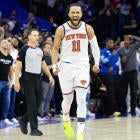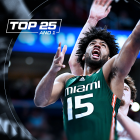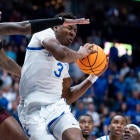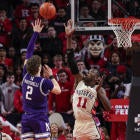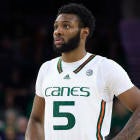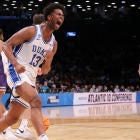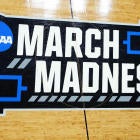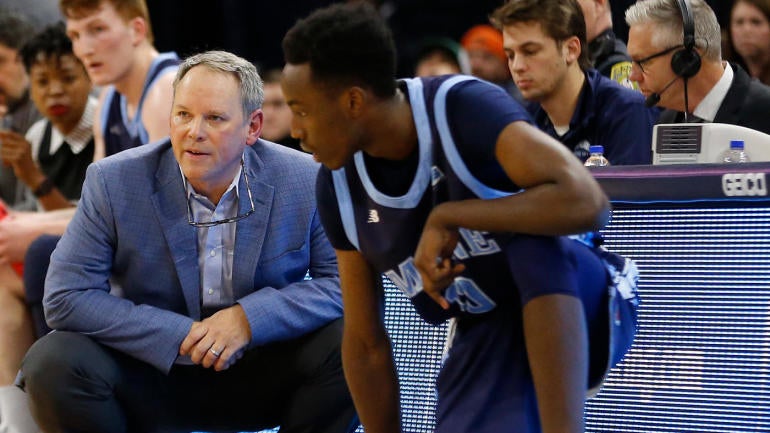
Imagine traveling 10,766 miles -- round trip! -- just to take a 40-point loss.
That's what happened to Maine on Sunday. The Black Bears and the University of Hawaii made history when they agreed last offseason to schedule a game that would become the longest inter-United States trip in the history of college athletics. On Sunday, Hawaii (9-5) was a thankful but ungracious host, beating Maine 91-51.
In reality, Maine (3-10) traveled even more than 10,766 miles (as the crow flies) when you account for flight patterns and the driving to and from each airport. The university is based in Orono, Maine, which is about a 20-minute drive to Bangor. The team departed at 5:45 a.m. ET on Saturday and didn't land in Honolulu until approximately 8 p.m. local that night. They flew from Bangor to Philadelphia (472 miles), Philadelphia to Chicago (675 miles), Chicago to Honolulu (4,236 miles).
That's 19 hours of travel time -- nearly 40 hours, all told, for the whole trip when factoring in bus rides to and fro.
The team departed Hawaii around 5:30 p.m. local on Monday, flew overnight to Chicago and didn't return to campus until close to 4 p.m. on New Year's Eve. Here's the scope of the trip, via Google Maps. Each pin location is an airport the team traveled through. I think people often don't appreciate just how far out there Hawaii is.
"Might be the dumbest game ever scheduled," one coach, all too familiar with the challenges of low-major scheduling realities, told CBS Sports. "It makes zero sense."
That might be! Yet it's still fascinating. So why did it happen? A couple of reasons. The first being that Hawaii's coach and support staff keeps tabs on hundreds of schools annually to determine which ones have the flexibility -- let alone want -- to head out to O'ahu to get in a game. Hawaii coach Eran Ganot pulls this off each year, in part, thanks to the fact that he can sometimes get a team playing in the Maui Invitational to check off one more game. It happened with North Carolina a few years ago, and Ganot told CBS Sports on Tuesday that Roy Williams has already agreed to do it again next season, when UNC heads back to Maui (which, to be clear, is on a different island from Hawaii's campus and home arena).
What's more, the NCAA allows all nonconference games played at Hawaii an exempt status, meaning that though the win or loss counts in the books, scheduling the game doesn't count against a team's total allotted number of 31 possible games before conference tournament play.
And then, finally, the most important factor: Hawaii foots the bill. The school most often pays for opponents' flights, road transportation and hotel accommodations when they schlep all the way out to the middle of the Pacific Ocean. And that's why Hawaii can still manage nine or 10 nonconference home games each season. Financially, this barely cost Maine anything.
For that team, undoubtedly a cool trip, but those players will need some hot tub treatment to get rid of the stiffness from flying more than 11,000 miles by commercial air. Credit to Maine coach Richard Barron for agreeing to the trip; Hawaii director of basketball operations Jesse Nakanishi had been working to get this game done in recent years, and clearly he wasn't shy about the opportunity.
But still, all this for a 40-point loss. Yikes!
The game was also Ganot's debut this season. He'd been out the past two months due to a personal health issue that he's opted not to publicly disclose. But in speaking with Ganot on Tuesday, he's high in spirit, doing physical therapy and happy to be back on the bench.
Because my brain works in weird ways, I wondered: if you eliminated Hawaii as an end point, what's the longest possible road trip between two Division I schools in college basketball? My first instinct was correct: if you factor in driving from each respective campus to the closest airport, Miami at Washington is the longest trip (2,727 miles between the airports, as the crow flies) in the lower 48.
Sean Miller's frosh experiment will determine Zona's season
The 10-3 Arizona Wildcats have maintained a place in the rankings every week so far this season, even clinging on to No. 25 this week after falling against St. John's in their most recent game on Dec. 21.
But for Miller, this season is new territory: he's relying on a trio of freshmen, something that's never been the case at Arizona. There have been teams with highly rated freshman classes, but no Arizona team has ever been so reliant -- and this is statistically proven -- like this year's squad is relying on point guard Nico Mannion, shooting guard Josh Green and power forward Zeke Nnaji.
"Our best class was Kaleb Tarczewski, Brandon Ashley, Gabe York, Grant Jerrett, but there was a blend there," Miller told CBS Sports. "This is the most we've relied on freshmen for sure. They're our top three scorers, they lead our team in minutes, shots taken, rebounding, assists, everything."
Miller told me it's been a stimulating challenge, but the best part of this is that all those freshmen -- and the team in general -- has had such an ambitious and open attitude.
The freshman experiment is working -- to a point. Mannion's shot has been inconsistent as of late, and his forgettable-but-unforgettable 3-of-20 shooting nightmare in the 84-80 home loss to Gonzaga on Dec. 14 was his nadir. Nnaji's one of the most efficient offensive players in the country, but he's still getting a grasp on defensive consistency and intel. Those two are two of the six best freshmen in America at this point. Meantime, it's Green who's on the steepest ascent.
"From the start of the preseason until now, Josh Green has made bigger strides than anyone," Miller said.
The fact Mannion (who was born in Italy and played internationally) and Green (who is from Australia and played internationally) have been exposed to such high-profile basketball prior to Arizona has been helpful.
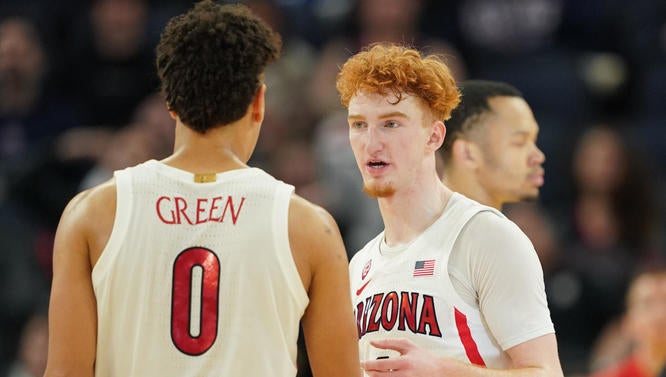
Here's a closer look at just how much Miller needs this troika in order to make the NCAA Tournament:
Mannion accounts for:
- 17.6% of team's points
- 36.5% of team's assists
- 19.3% of team's shots
- played 76.5% of team's minutes
Nnaji accounts for:
- 19.8% of team's points
- 21% of team's rebounds
- 14.5% of team's shots
- 27.8% of team's blocks
- played 70.8% of team's minutes
Green accounts for:
- 15.4% of team's points
- 13.6% of team's rebounds
- 23.4% of team's steals
- 17.1% of team's shots
- played 76.3% of team's minutes
Add 'em up and that's 55.9% of Arizona's assists, 57.5% of its free throw attempts, 52.8% of its points, 50.8% of its shots and 39.8% of its rebounds solely coming from Green, Mannion and Nnaji.
Miller knows that, despite being ranked each week and having a relatively healthy record, the nonconference didn't assure this team of anything, especially not after last season's ho-hum 17-15 record.
"Losing at Baylor, losing [to Gonzaga], I wish we could have won them but we didn't," he said. "We have to come back after Christmas and play really well in the Pac-12."
He'll take 10-3 to this point with reliance on this freshmen group, though.
"We have a high ceiling, but just because we have a high ceiling doesn't mean you're going to get there," Miller said. "We have to get there."
July recruiting just got better, stronger
I know we're in the thick of the season here, but somewhat quietly a major piece of recruiting news was released in December. While Nike, Under Armour and Adidas take up a lot of the space in April/early May and July, there are independent recruiting events that get help get hundreds of players scholarships annually. And now the first July live period is going to be all the better.
Two independent groups -- HoopSeen and NY2LA Sports -- will team up and hold a massive tournament in Atlanta next July. It's called the Best of the South and it will arguably bring in as many coaches and schools as any other event, the famed Peach Jam included. The event is anticipating north of 1,000 college coaches. It's a terrific thing for recruiting and an important reminder that alterations to the calendar, while well-intended, didn't take into account events like this that are necessary for the educational and scholarship opportunities for less-heralded players who need them most.
"We saw this as an opportunity to provide an unparalleled stage for a giant slice of college and summer basketball, the independent sponsored teams," HoopSeen president Justin Young told CBS Sports. "Pairing with NY2LA was so important to maximize opportunity for everyone involved. We think it's a win and so did every single college coach that came last year and every single coach that we've talked to about it since the partnership. When you only have four days to watch travel teams, logistics are everything. So, putting enough courts under one roof in downtown Atlanta, the new hub for travel basketball, was the best move for those that don't play on a shoe circuit."
Teams from more than 30 states (maybe 40) will be involved, playing on 40 courts at the Georgia World Congress Center. The expectation is 700 teams will play in the event in July. Think about how many college prospects that is -- at all levels.
This is a great thing for college basketball and should bolster July, at least to the point where coaches can get strong evals done in a geographically friendly area. Even coaches on tighter travel budgets will inevitably do same-day travel from Peach Jam (in North Augusta, South Carolina) to Atlanta.
@ me
Have a question, curiosity or complaint? Do @ me. Lob your question my way on Twitter. And this week I'm doing a beefed-up mailbag!
Over/under 3.5 SEC bids in NCAA Tournament, @MattNorlander @3MW_CBB ???
— The D1 Docket (@TheD1Docket) December 30, 2019
Predicting the SEC receives a mere three NCAA Tournament bids for 2020 seems laughably low. And yet: the league ranks fifth at KenPom; there are only three teams in the NET top 40 (Auburn, Arkansas, LSU); and eight teams have already taken at least four losses. While I would still firmly rate it unlikely, it is not unthinkable that the SEC twists itself into three-bid territory. As we head into 2020, we simply don't know which direction these teams are headed and which ones will split off to fight with Kentucky and Auburn near the top of the league between Florida (8-4), Arkansas (11-1), LSU (8-4), Tennessee (8-4), Mississippi State (9-3), Georgia (9-3), Ole Miss (9-3). For the record, my guess is the SEC winds up with five in the field of 68.
What is Butler’s ceiling this year?
— DB (@DLBrown24) December 31, 2019
New Year's Eve got interesting, as Butler almost blew a 23-point lead at St. John's, but won 60-58 to get to 13-1. I plan on having some more in-depth stuff on Butler in the Court Report in the first couple of weeks of 2020. Right now, Butler's ceiling looks to be a No. 1 seed and making the Final Four. I'm sorry to be the bearer of good news.
4 players in NCAA DI history have scored 2,000 points and recorded 800 assists. Will we ever see someone else achieve that feat?
— Bobby Reagan (@BarstoolReags) December 31, 2019
Cassius Winston (1,622 points, 786 assists) is set to become No. 5. It's hard to pull off, but barring an asteroid finding us in the next 30 years, it's going to happen again. They'll be playing college basketball for centuries, and thank the hoop lords for that. If you're curious, here are the four who have gone for 2,000/800: Syracuse's Sherman Douglas, Notre Dame's Chris Thomas, Oregon State's Gary Payton and Ohio's D.J. Cooper.
What team in the middle of the B1G (4-12) emerges to make a run in tourney? I’m putting OSU, Mich, & MSU in top 3.
— Kraig Bowers (@kraigbowers34) December 31, 2019
Maryland is so easily my candidate here. I think Maryland will finish third in the standings at season's end.
Will P5 Conferences playing 20 league games kill Mid Majors getting out of league opportunities in the non conference schedule.
— Eric Aldridge (@ealdridge1389) December 31, 2019
By next season, the only power conferences that definitely won't be playing 20-game league schedules are the Big 12 and the American Athletic Conference. The SEC still has not announced whether it will be staying at 18 or folding to pressure and going to 20. I hate 20. Many coaches hate 20. It does dwindle opportunities for would-be bubble teams in mid-major leagues. This season is going to be an interesting trial ground and it's on the selection committee to arbitrate against this and give smaller schools with fewer opportunities (and way more land mines) the benefit of the doubt when splitting hairs against big-league schools.
I’m an Illinois fan. Can we still make the tournament?
— Eric Litz (@elitz25) December 31, 2019
You can and will. Illinois will be an 11 seed after dancing on the edge for the final six weeks of the regular season.
How many league wins is enough for 1st in Big East and who finishes last?
— Bucket Hat Monk (@hat_monk) December 31, 2019
I think a 13-5 record gets it done and gets you the 1 seed in the BET this season. The bottom will have co-occupants: Georgetown and St. John's will get to seven wins.
Where does Arkansas finish in the SEC?
— Brock Haegele (@TheHaegelBagel) December 31, 2019
Gonna say sixth!
Are you excited about the new season of Doctor Who starting up? Which Wisconsin Badgers team will show up going forward?
— Nuclear Badger (@nuclearbdgr) December 31, 2019
I am always excited for THE DOCKTAH. The Norlander household has a TV frequently on the Doctor Who marathon every Christmas. As for the Badgers, say hello to maybe the oddest team in high-major hoops. An 8-5 record with wins vs. Marquette and Indiana, plus at Tennessee. Losses to Richmond, New Mexico and Rutgers. Ranked 46th in the Massey Composite. I do not trust this team!
Who wins a national title first between these struggling but historically great programs:
— Ben Cary (@zagfan8741) December 31, 2019
Georgetown, UCONN, Arkansas, UCLA, Syracuse, or St. John’s?
This is a good question to wrap with. UConn a weird inclusion, given it's got four titles and two came in the past decade. It also has the most optimistic coaching situation at the moment. I do lean UConn over all the others. Heading back into a great situation next season in the Big East -- with a good coach -- and the ability to recruit to its level as well or better than any other program listed. I would pick UCLA second. Mick Cronin has been to 11 NCAA tourneys and has a lot of advantages at UCLA that give him a good shot to make a Final Four ... eventually.
Final shots
- Since the bag was long, only one shot here. I don't know who compiled this, but thank you. If you've got 30 minutes to kill, why not? It's the 100 best plays of the past 10 years in college hoops. An extremely fun stroll over many plays you've forgotten -- and some you never saw.













